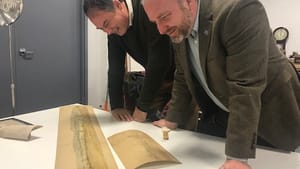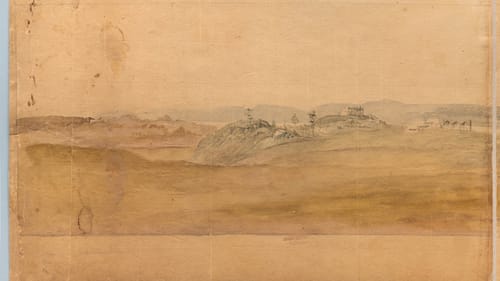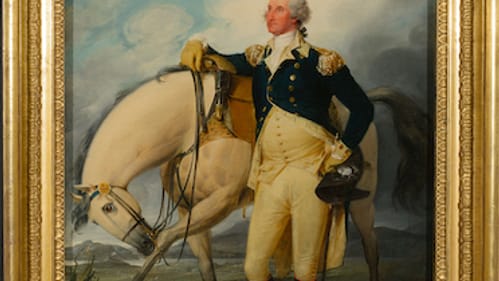Stay in the Loop
BSR publishes on a weekly schedule, with an email newsletter every Wednesday and Thursday morning. There’s no paywall, and subscribing is always free.
Searching for the leader of a republic
Museum of the American Revolution's 'Among His Troops'

“Right now, we’re doing a lot of looking back at other moments of American crisis,” says Dr. Philip Mead, chief historian and director of curatorial affairs at the Museum of the American Revolution. A newly rediscovered panoramic watercolor by Pierre L’Enfant showing the Continental Army camped at Verplanck’s Point in 1782 is one of the most “unappreciated moments of crisis in American history.”
Page surfing pays off
Does it behoove all of us to take a moment and look back a time when things were arguably worse for the republic known as the United States? If nothing else, it’s a break from abysmally embarrassing daily headlines.
Mead introduced the painting at a preview of the new limited-run exhibition, Among His Troops: Washington’s War Tent in a Newly Discovered Watercolor.
Dr. R. Scott Stephenson, the museum’s vice president of collections, exhibitions, and programming, said Mead discovered the seven-foot-long painting (originally created on five pieces of paper, attached, and then folded up like an accordion for decades). This historian’s “night owl” tendencies paid off big time: according to Stephenson, Mead was perusing an online art auction late at night when he stumbled on a painting strikingly similar in style to L’Enfant’s 1782 panorama of West Point.
“Surely someone else is going to figure this out,” Stephenson said of their scramble to secure possible donors if any other historians caught on, but no one did. In their preparations to scoop up the painting, just a few weeks after the museum’s official opening in 2017, president and CEO Michael Quinn said they made plenty of “clandestine moves … that let us snatch this up for a song,” i.e., $13,000.

A tiny tent looms large
After the purchase, studies of the painting’s style, time period and place, provenance, and some handwriting on the back from the artist (who later produced the first layout for the city of Washington, D.C.) confirmed the historians’ suspicions.
Now, the painting is part of the museum’s permanent collection, and it’s on display beside L’Enfant’s West Point panorama, on loan from the Library of Congress. It’s a boon for the young museum, whose prime artifact is the tent in which George Washington lived and worked for years on the fields of the Continental Army’s campaign for independence.
That’s part of why the rediscovered painting is notable: measuring no more than a half-inch in the sweep of the view (painted from about a half-mile away), there’s a grand white tent corresponding exactly (in appearance and placement) to eyewitness accounts of Washington’s tent at Verplanck’s Point.
The exhibit includes some noble wartime depictions of Washington, including Joseph Wright’s 1784 portrait, and John Trumbull’s “Washington at Verplanck’s Point.” While the latter does not show the tent, it is painted as if the artist is looking out the doorway (Trumbull gave the painting to Martha Washington in 1790). There’s also Howard Pyle’s vision of Washington at work inside the tent, painted over 100 years later, with the lionizing title “In the Presence of Washington.”

Wartime welcome mat
Being in the presence of Washington isn’t just the point of exhibitions at the museum featuring his tent, portraits, and images and artifacts of his wartime encampment. It was also the point of the tent itself, which Washington used as an office and living quarters, instead of holing up somewhere more comfortable.
Mead noted that Washington “looks pretty vulnerable here.” But his presence was a robust signal to the flagging Continental army and to visiting French military, whose funding the colonial leaders desperately needed.
Mead and Stephenson emphasized that the scene at Verplanck’s Point, though it comes a year after the Continental Army’s historic victory at Yorktown, marks a potentially ruinous low in U.S. history: the Brits were considering a renewal of military force against their former colony, and promises of payment for the Revolutionary soldiers ran thin. Then, as now, military and political leadership was as much a matter of optics as anything else.
As Mead put it, Washington chose to sleep in the field partly because “there is a question of whether leadership of a republic is a real thing.”
A lot of us are probably asking ourselves the same question now, though they’d probably have to look at Twitter or a golf course for an answer.
While the show does, for example, touch on the contributions of African-American soldiers and women to the revolutionary effort, I wish Philadelphia-area author Erica Armstrong Dunbar’s Never Caught, the true story of the only slave who escaped from George and Martha Washington’s household, was required reading for everyone touring this exhibit.
In a tumultuous American present, it’s difficult to draw inspiration from an idolized figure who was himself a slave owner, whether or not he bravely camped among his troops (some of whom were black). But it’s impossible not to hope that L’Enfant’s lush, tiny brushstrokes capture the beginning of something that will outlast our current crisis.
What, When, Where
Among His Troops: Washington’s War Tent in a Newly Rediscovered Watercolor. Through February 19, 2018, at the Museum of the American Revolution, 101 S. Third Street, Philadelphia. (215) 253-6731 or amrevmuseum.org.
Sign up for our newsletter
All of the week's new articles, all in one place. Sign up for the free weekly BSR newsletters, and don't miss a conversation.
 Alaina Johns
Alaina Johns